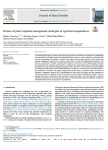Piñeiro V., Martinez-Gomez V., Meliá-Martí E., García Alvarez-Coque J.-M. (2021). Drivers of joint cropland management strategies in agri-food cooperatives. Journal of rural studies, 01/05/2021, vol. 84, p. 162-173.
https://doi.org/10.1016/j.jrurstud.2021.04.003
https://doi.org/10.1016/j.jrurstud.2021.04.003
| Titre : | Drivers of joint cropland management strategies in agri-food cooperatives (2021) |
| Auteurs : | V. Piñeiro ; V. Martinez-Gomez ; E. Meliá-Martí ; J.-M. García Alvarez-Coque |
| Type de document : | Article |
| Dans : | Journal of rural studies (vol. 84, May 2021) |
| Article en page(s) : | p. 162-173 |
| Langues : | Anglais |
| Langues du résumé : | Anglais |
| Catégories : |
Catégories principales 06 - AGRICULTURE. FORÊTS. PÊCHES ; 6.5 - Gestion des ExploitationsThésaurus IAMM COOPERATIVE AGRICOLE ; ACTION COLLECTIVE ; TERRE ABANDONNEE ; PETITE EXPLOITATION AGRICOLE ; APPROVISIONNEMENT ; TERRE CULTIVEE ; GESTION ; ESPAGNE |
| Résumé : | In several Spanish regions, collective action through production and marketing cooperatives has traditionally concentrated the food supply of small and medium-sized farms. However, many cooperatives are threatened by the risk of abandonment of members' cropland, which reduces their sourcing capacity. In this context, joint cropland management initiatives have become a useful form of social and organizational innovation. This research's contribution is twofold: it examines the relevance of some drivers of this organizational innovation, and it determines the cooperative characteristics or combinations of characteristics that can sufficiently explain the adoption of a joint cropland management strategy. Some cooperatives' features have been a priori identified as related to the achievement of joint cropland initiatives: economic size, social innovation, innovative behavior, and collaborative orientation. The study is mainly based on data from a cooperatives survey, and fuzzy set Qualitative Comparative Analysis (fsQCA) methodology has been used. The analysis has been completed by surveying cooperatives' managers about their opinions on a joint cropland management strategy's main advantages and drivers. Results indicate that social and economic innovation, size, and propensity to cooperate with other cooperatives are key factors that help create a cooperative profile capable of tackling the challenge of land abandonment and the consequent loss of production. |
| Cote : | Réservé lecteur CIHEAM |
| URL / DOI : | https://doi.org/10.1016/j.jrurstud.2021.04.003 |







